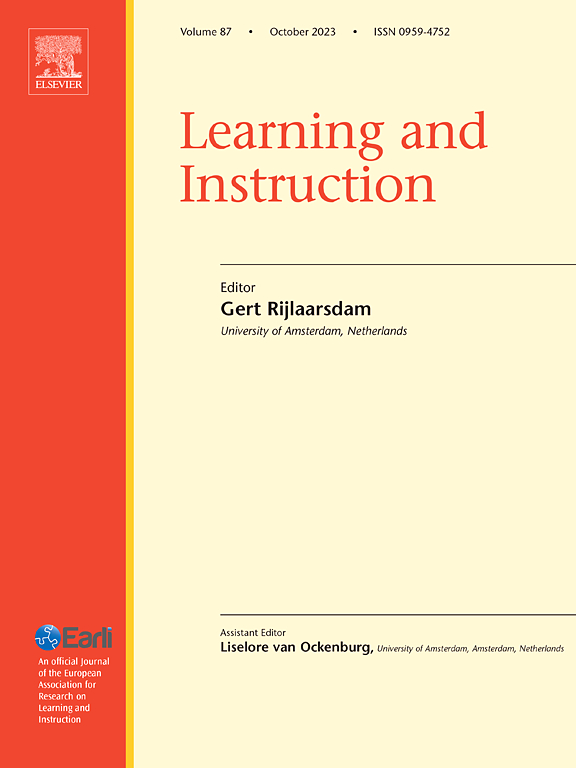认知激活对学生成绩的直接影响是否足够?探索适应和利用机遇的作用
IF 4.9
1区 教育学
Q1 EDUCATION & EDUCATIONAL RESEARCH
引用次数: 0
摘要
尽管认知激活已受到越来越多的学术关注,但其对学生成绩的贡献的研究结果尚无定论。我们认为,这可能是由于许多研究没有调查的两个核心条件:与认知激活相关的学习机会应该适应学生的需求,学生必须利用提供的学习机会。我们通过比较一个只包含认知激活对学生认知和情感结果的直接影响的模型与包含适应和利用机会影响的调节、调解和调节调解模型来验证这一论点。我们的样本包括496名教师和13326名中学生,他们来自6个参与了TALIS视频研究的教育系统。方法首先对每个教育系统分别进行参数估计的多层路径模型进行估计。然后,我们量化了整体效应和异质性程度,检验了(a)在控制T1的情况下,适应是否调节了T2认知激活对学生成绩/兴趣的影响,(b)加工深度是否介导了这种影响,以及(c)适应是否通过加工深度调节了认知激活与学生成绩/兴趣之间的中介效应。结果直接效应模型结果不确定。最令人鼓舞的结果出现在中介模型中,但仍有些喜忧参半。虽然一些更复杂的模型有望捕捉教学对学生成绩的影响,但不同教育系统、分析水平和结果的不同发现表明,教学如何促进学习的机制存在差异。本文章由计算机程序翻译,如有差异,请以英文原文为准。
Are direct effects of cognitive activation on student outcomes enough? Exploring the role of adaptation and use of opportunities
Background
Although cognitive activation has been receiving growing scholarly attention, research findings on its contribution to student outcomes have been inconclusive. We argue that this might be due to two core conditions not investigated by many studies: learning opportunities related to cognitive activation ought to be adapted to student needs and students must make use of the provided opportunities to learn.
Aims
We tested this argument by comparing a model that included only direct effects of cognitive activation on student cognitive and affective outcomes against moderation, mediation, and moderated mediation models that incorporated the effects of adaptation and use of opportunities.
Sample
Our sample included 496 teachers and 13,326 secondary school students from six educational systems that had participated in the TALIS Video study.
Methods
We first estimated multilevel path models with separate parameter estimations for each educational system. Then we quantified the overall effects and degree of heterogeneity, testing whether: (a) adaptation moderates the effect of cognitive activation on student achievement/interest at T2 while controlling for T1, (b) depth of processing mediates this effect, and (c) adaptation moderates the mediated effect between cognitive activation and student achievement/interest via depth of processing.
Results
The direct-effects model yielded inconclusive results. The most encouraging, yet still somewhat mixed, results emerged from the mediation model.
Conclusions
While some of the more complex models show promise in capturing the impact of teaching on student outcomes, the varied findings across educational systems, analysis levels, and outcomes suggest diverse mechanisms in how teaching contributes to learning.
求助全文
通过发布文献求助,成功后即可免费获取论文全文。
去求助
来源期刊

Learning and Instruction
Multiple-
CiteScore
11.30
自引率
4.80%
发文量
109
期刊介绍:
As an international, multi-disciplinary, peer-refereed journal, Learning and Instruction provides a platform for the publication of the most advanced scientific research in the areas of learning, development, instruction and teaching. The journal welcomes original empirical investigations. The papers may represent a variety of theoretical perspectives and different methodological approaches. They may refer to any age level, from infants to adults and to a diversity of learning and instructional settings, from laboratory experiments to field studies. The major criteria in the review and the selection process concern the significance of the contribution to the area of learning and instruction, and the rigor of the study.
 求助内容:
求助内容: 应助结果提醒方式:
应助结果提醒方式:


